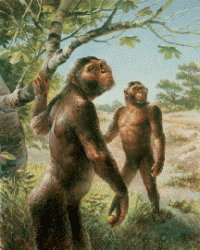Ancient human ancestor's teeth reveals diverse diet

Expansion of our ancestor's diet millions of years ago may have been a transformational stage in our ecological and evolutionary history. In four related research articles, scientists argue that human ancestors living 3.5 million years ago were the first hominins – species more closely related to humans than to chimpanzees – to show evidence of expanded preferences in their plant diet. The addition of tropical grasses and sedges to an ape-like diet set the stage for our modern diet of grains, grasses, and meat and dairy from grazing animals.
Diet has long been implicated as a driving force in human evolution. Changes in the type of food consumed and the manner in which it was gathered have been linked with the growth of brain and the emergence of bipedalism, as well as ecological, social, and cultural evolution within the hominin lineage.
The papers appeared in the June 3 issue of the Proceedings of the National Academy of Sciences.
Two of the papers, "Isotopic evidence of early hominin diets: Past, present, and future" and "Diet of Australopithecus afarensis from the Pliocene Hadar Formation, Ethiopia," include Institute of Human Origins director William Kimbel and research associate Kaye Reed as coauthors among a group of researchers from across the U.S.
Australopithecus afarensis was discovered and named by a team led by IHO founding director, Donald Johanson, who found the fossil skeleton "Lucy" at Hadar, Ethiopia, in 1974. Kimbel and Reed are professors in the School of Human Evolution and Social Change in the College of Liberal Arts and Sciences.
In the new work, the scientists used carbon isotope analysis to extract the dietary signal from fossilized teeth of African hominin species dating from 4.5- to 1.5-million years ago.
Isotope analysis is based on the concept that "you are what you eat." The carbon isotopic composition of past meals is incorporated into the forming tooth enamel, frozen in time yet recoverable after millions of years. Carbon isotopes are especially valuable for distinguishing diets based on "C3" or "C4" plants, which differ in how efficiently carbon is recovered during photosynthesis. C3 plants include trees, shrubs, and herbs and predominate in forested conditions or around well-watered areas. C4 plants are the grasses and sedges that inhabit primarily open environments. In living animals, carbon isotope ratios in tooth enamel readily distinguish grass feeders like zebra and wildebeests from fruit or leaf eaters like chimpanzees and giraffes.
Scientists have collected carbon isotope data from 173 specimens representing 11 early hominin species ranging in age from 4.4 million years ago to 1.3 million years ago. In the new research, A. afarensis from the Hadar and Dikika sites in Ethiopia was analyzed for the first time.
The diets of the earliest hominin species, Ardipithecus ramidus and Australopithecus anamensis from 4.4 to 4 million years ago, were dominated by C3 plants. But beginning around 3.5 million years ago, data from Hadar and Dikika in Ethiopia and West Turkana in Kenya show that A. afarensis and another species called Kenyanthropus platyops consumed foods from both C4 and C3 plant communities. This expansion in dietary preference represents the first use of C4 plant foods that had been abundant in the environment for at least one million years. All subsequent hominin species were capable of consuming both C3 and C4 foods, a flexible adaptation that was inherited by modern humans.
"We knew that before four million years ago, hominins had ape-like diets from an isotopic perspective and that after three million years ago, the diet had expanded to include a wide array of novel resources," observed Kimbel. "The time period of A. afarensis is key to pinning down exactly when this transition occurred."
What environmental factors may have led A. afarensis to expand its diet, and to exploit a larger range of habitats than any human ancestor species before it, is the subject of the next stage of research.
"We have no idea what parts of C4 plants A. afarensis was eating," noted IHO's Kaye Reed. "Was it seeds, blades of grass, or roots? The most interesting finding to me is that some A. afarensis individuals utilized C4 plants almost exclusively, while other individuals within the same time period ate mostly C3 plant species. This high degree of variation is not what one sees in populations of chimpanzees, for example, so the fact that A. afarensis individuals have different diets was not expected."
The Institute of Human Origins is one of the preeminent research organizations in the world devoted to the science of human origins. A research center of the College of Liberal Arts and Science in the School of Human Evolution and Social Change, IHO pursues an integrative strategy for research and discovery central to its 30-year-old founding mission, bridging social, earth, and life science approaches to the most important questions concerning the course, causes, and timing of events in the human career over deep time. IHO fosters public awareness of human origins and its relevance to contemporary society through innovative outreach programs that create timely, accurate information for both education and lay communities.
More information:
Wynn, J. et al. Diet of Australopithecus afarensis from the Pliocene Hadar Formation, Ethiopia, Proceedings of the National Academy of Sciences, June 3, 2013.
Sponheimer, M. et al. Isotopic evidence of early hominin diets, Proceedings of the National Academy of Sciences, June 3, 2013.
Cerling, T. et al. Stable isotope-based diet reconstructions of Turkana Basin hominins, Proceedings of the National Academy of Sciences, June 3, 2013.
Cerling, T. et al. Diet of Theropithecus from 4 to 1 Ma in Kenya, Proceedings of the National Academy of Sciences, June 3, 2013.
Provided by Arizona State University